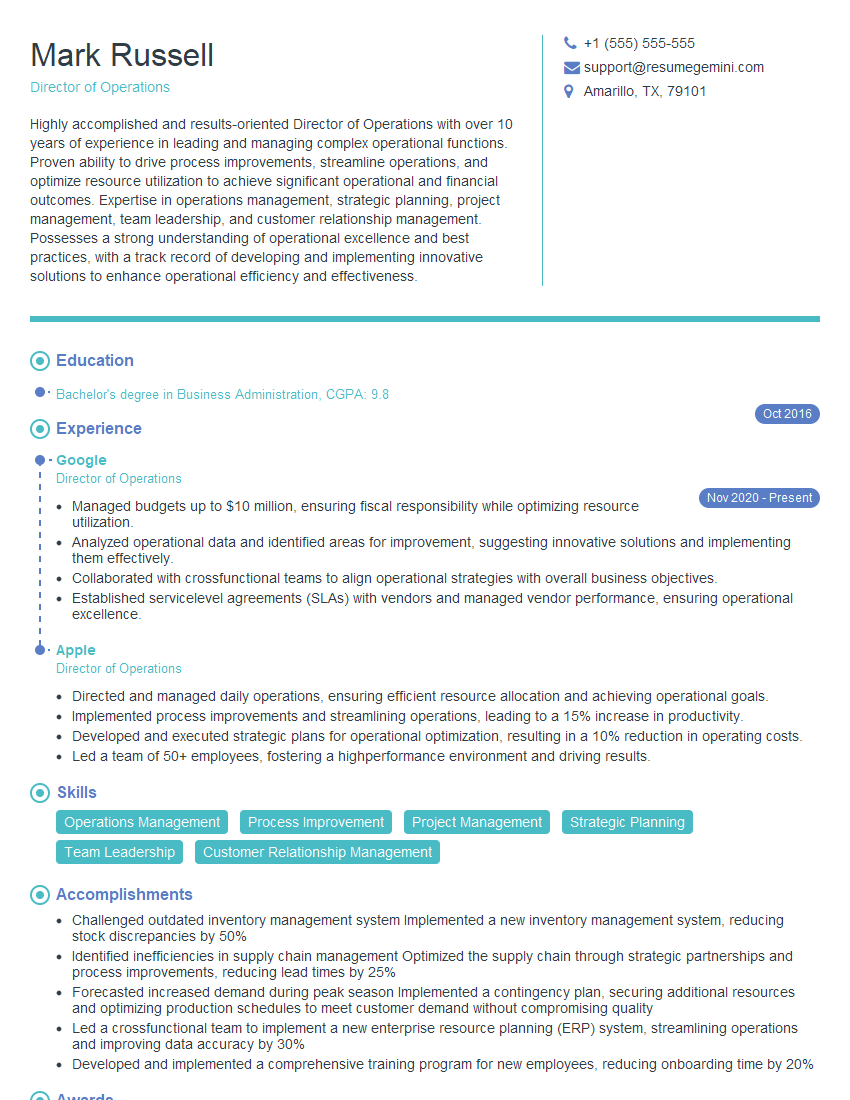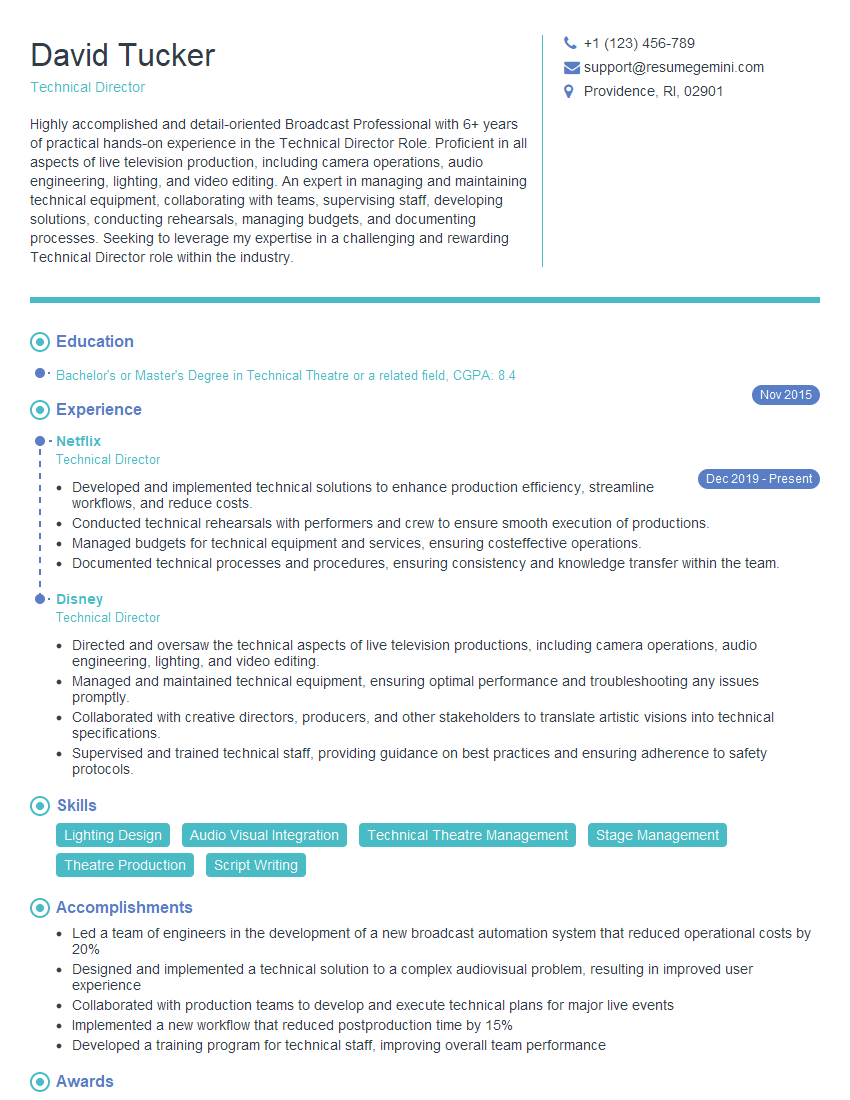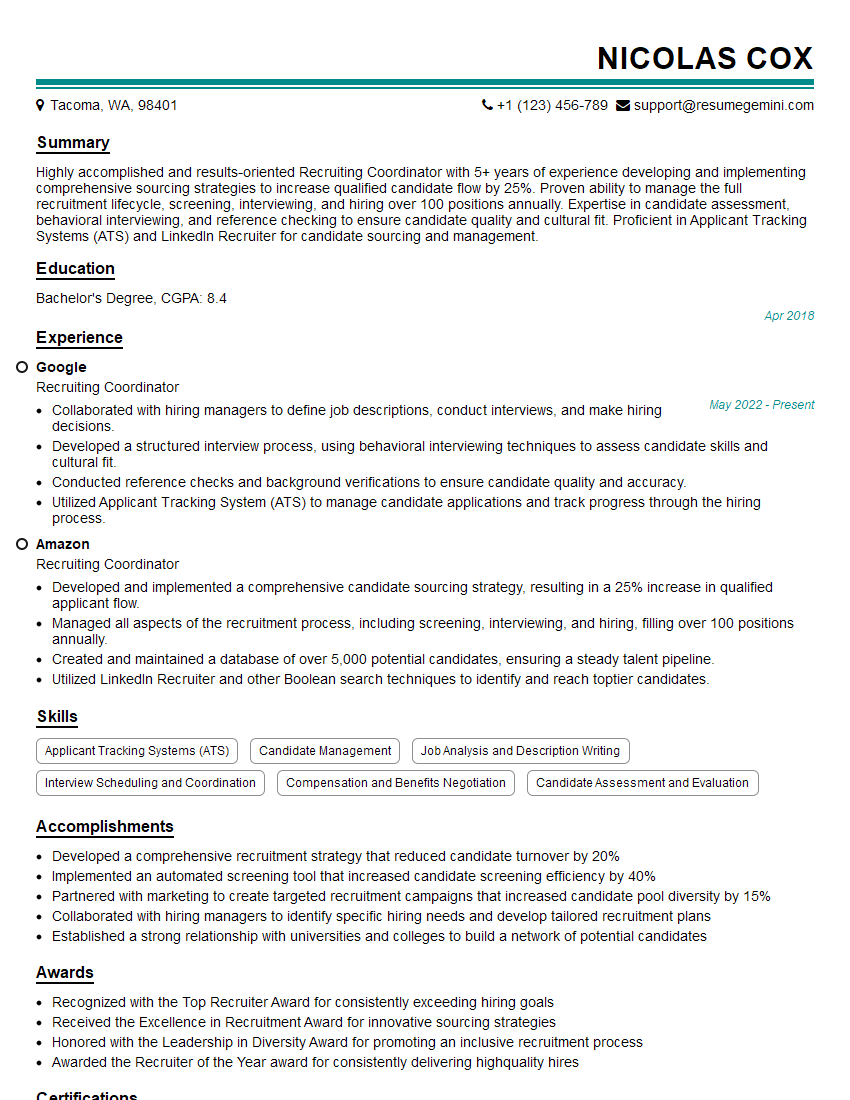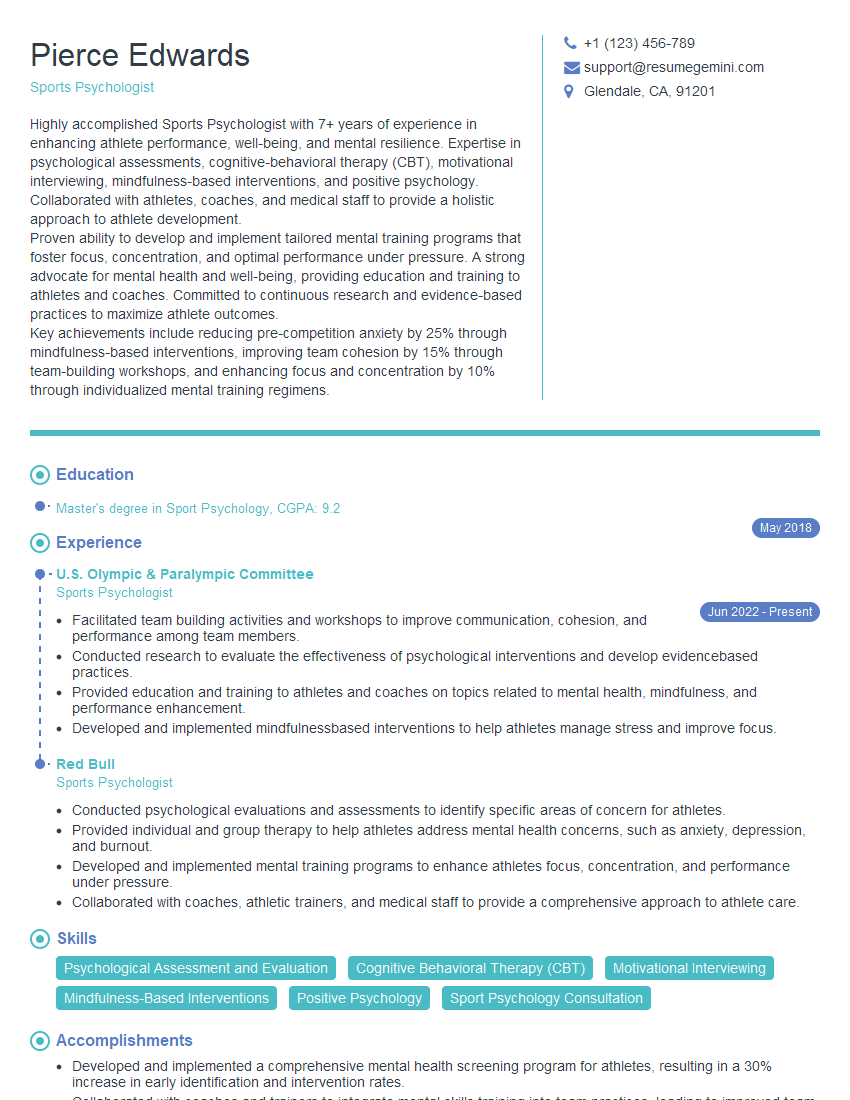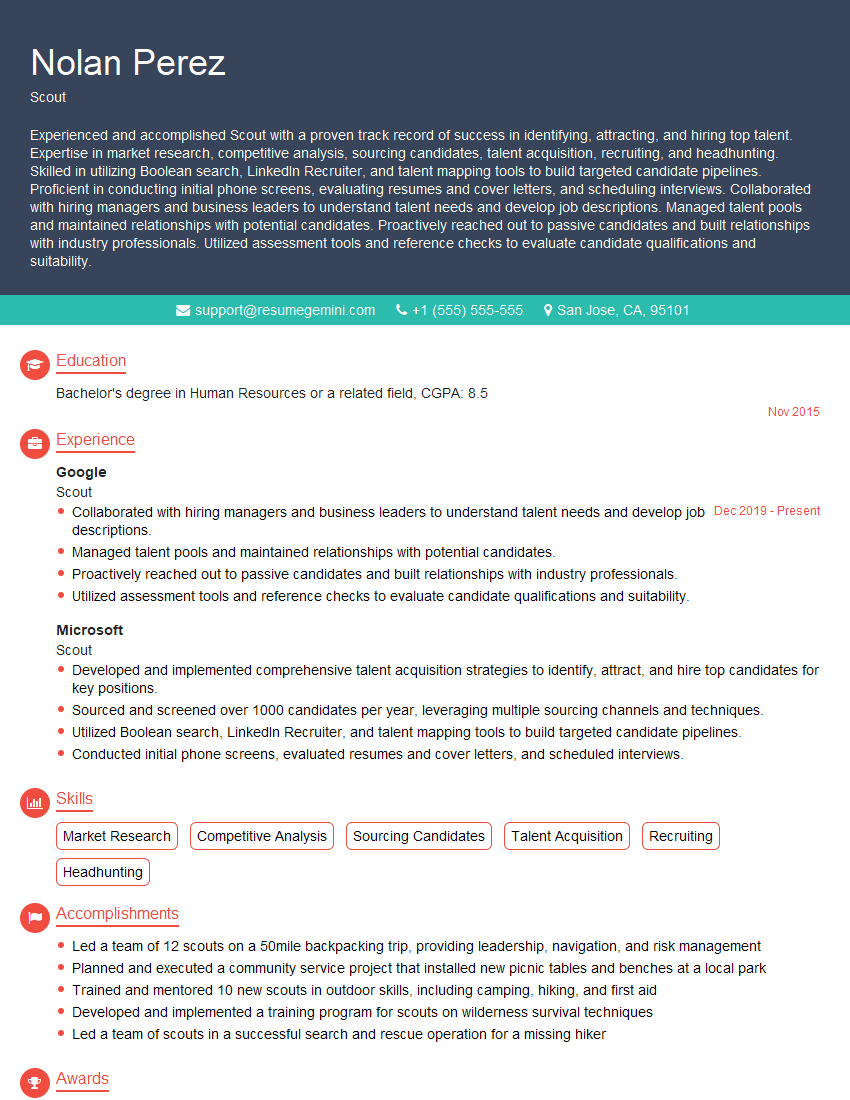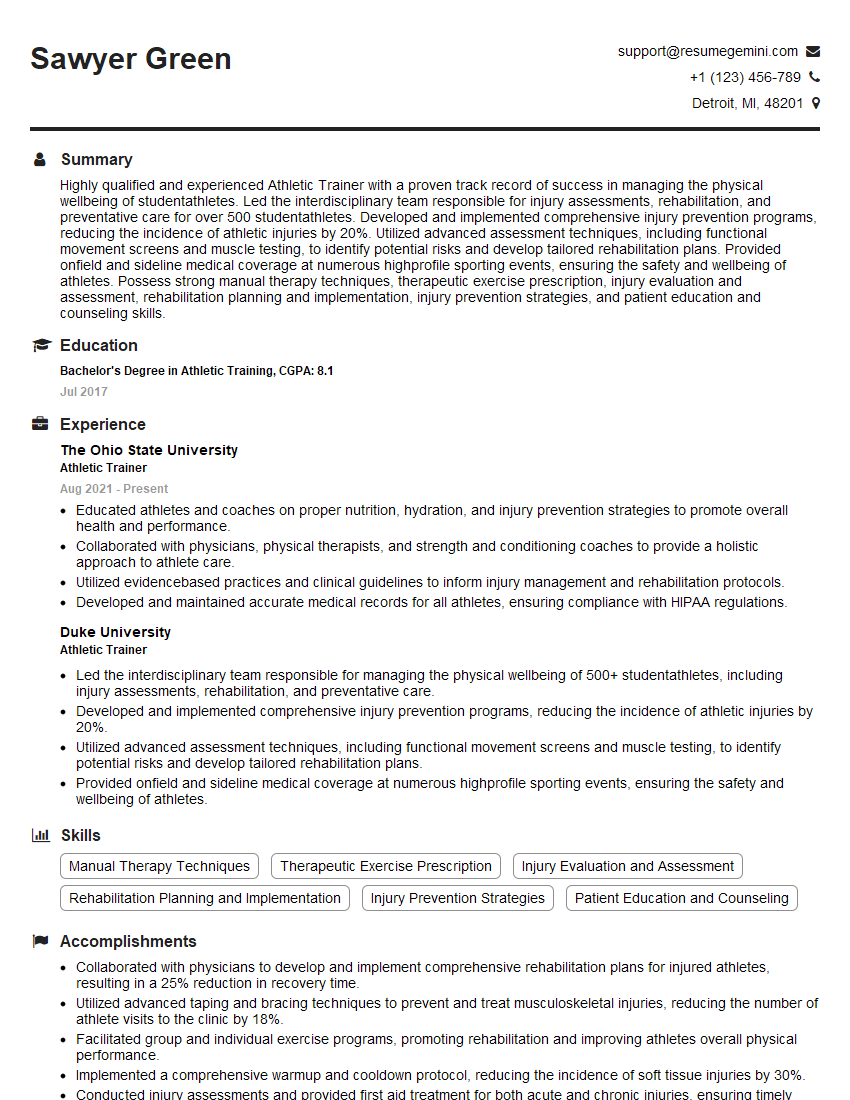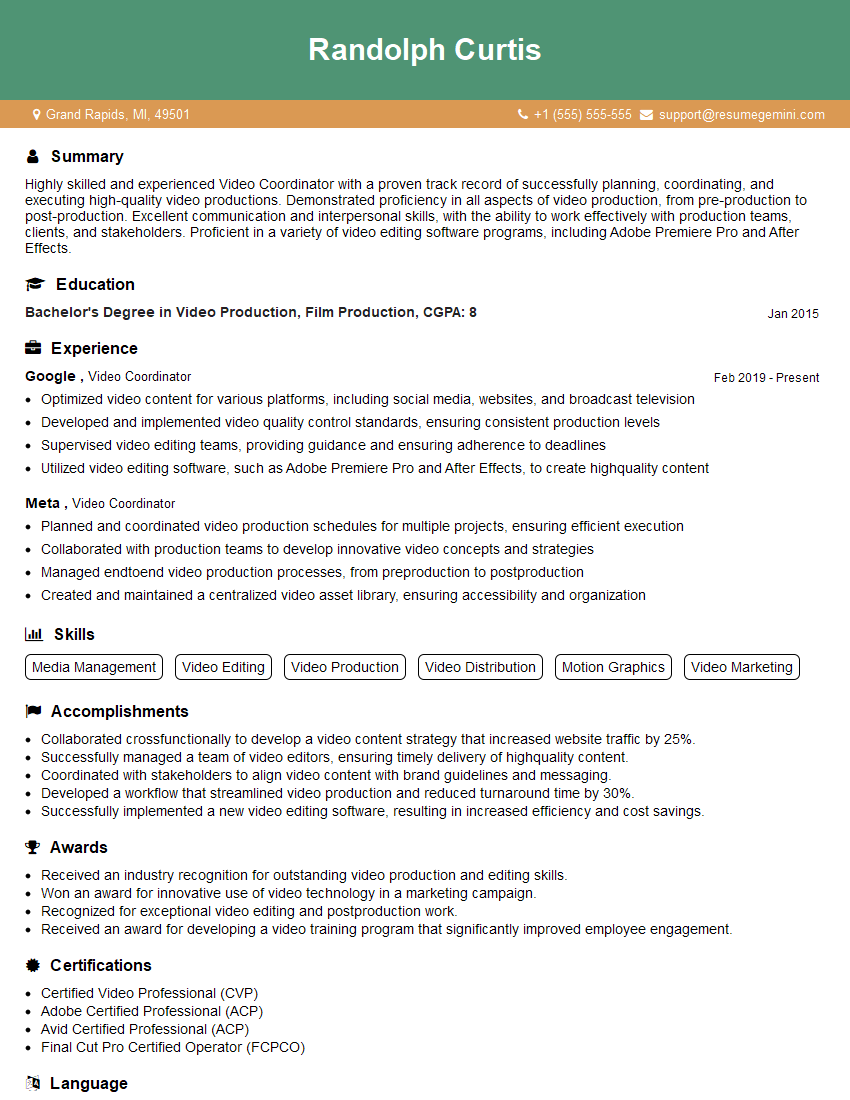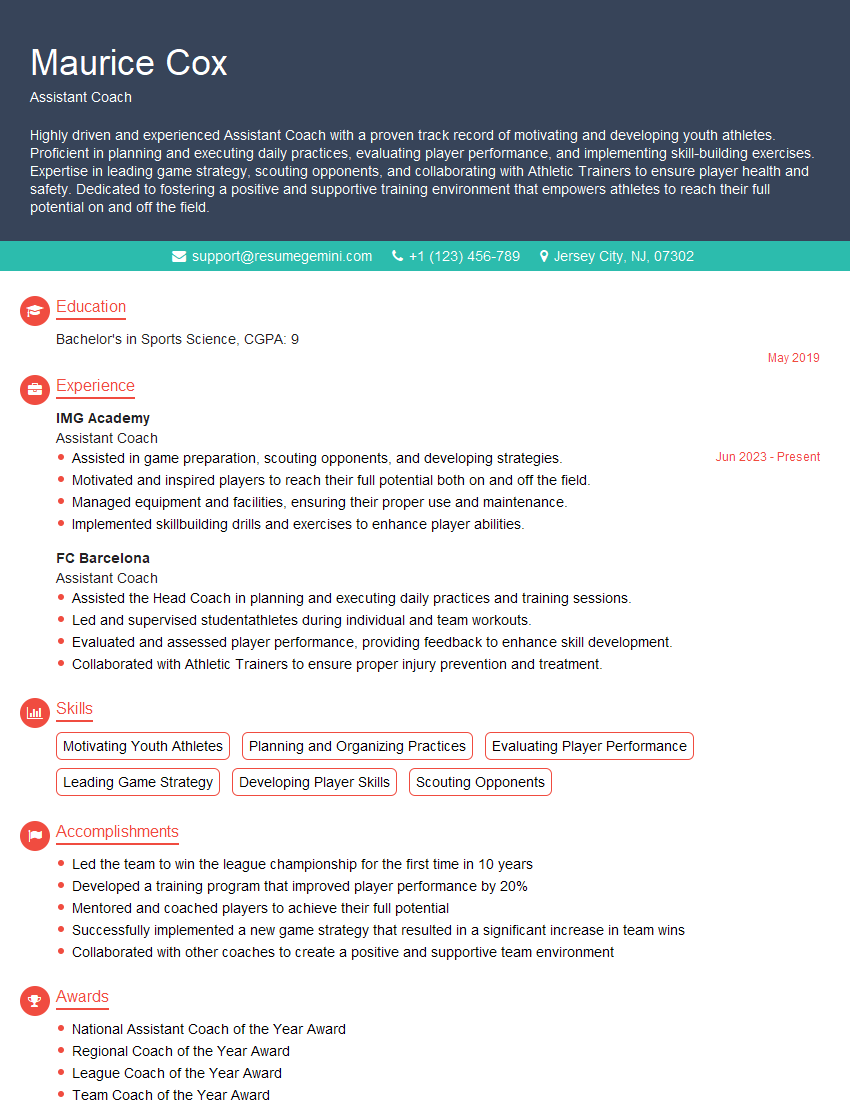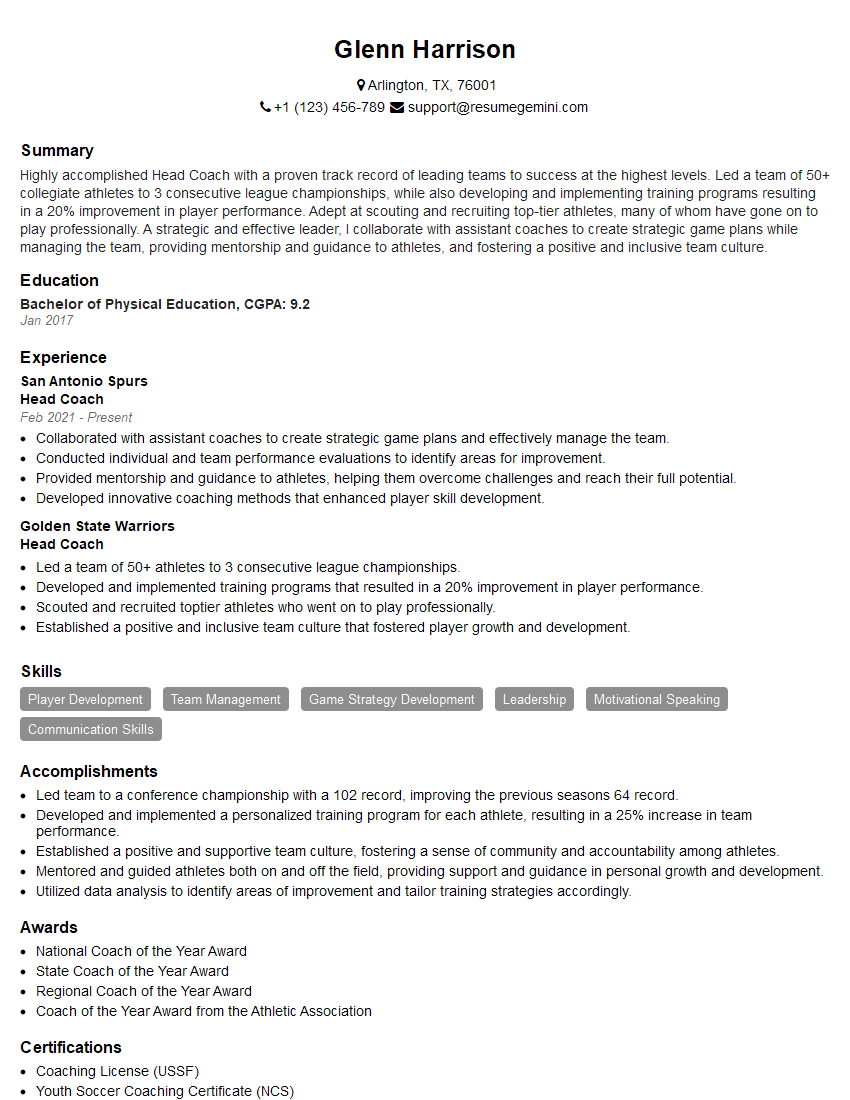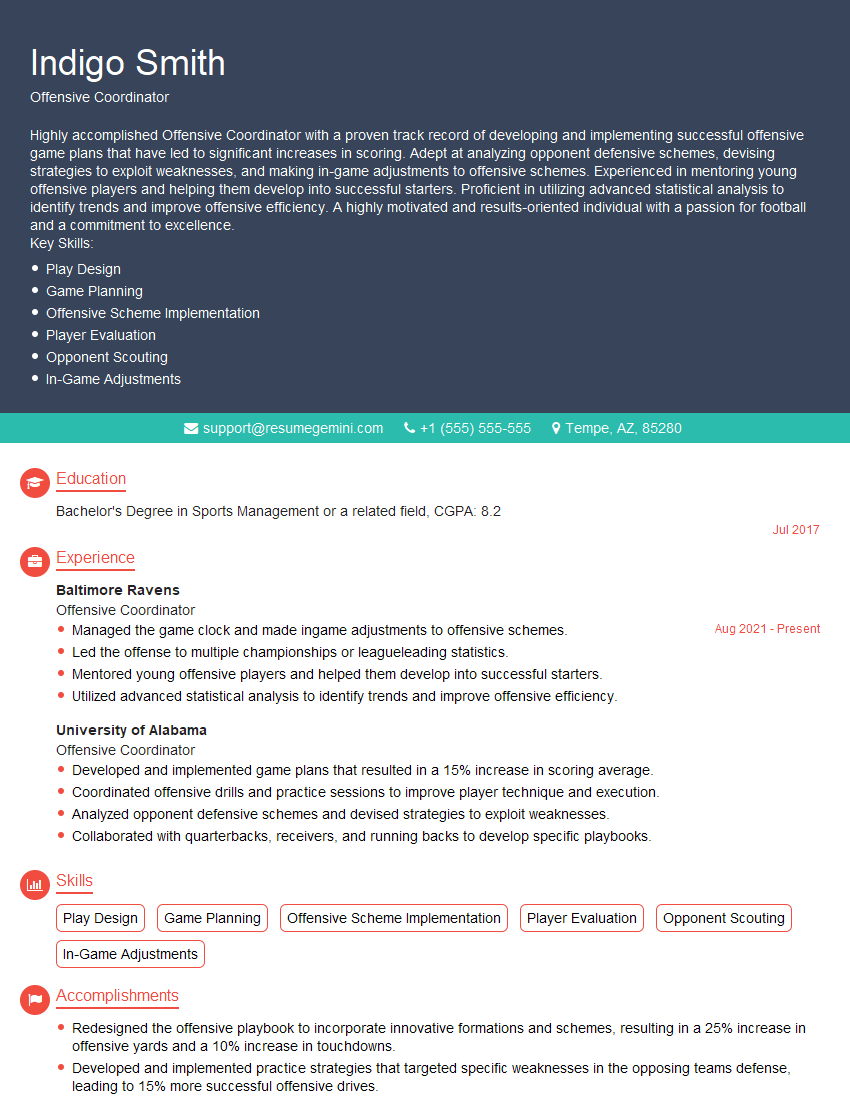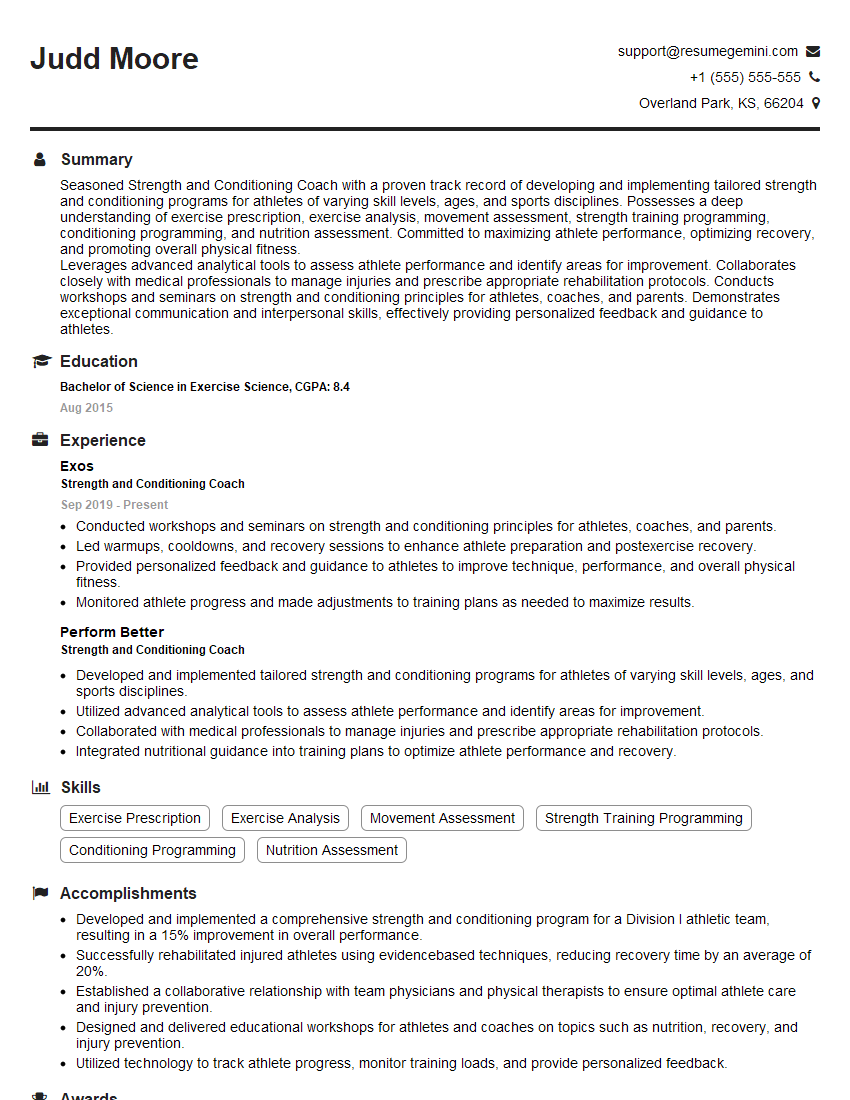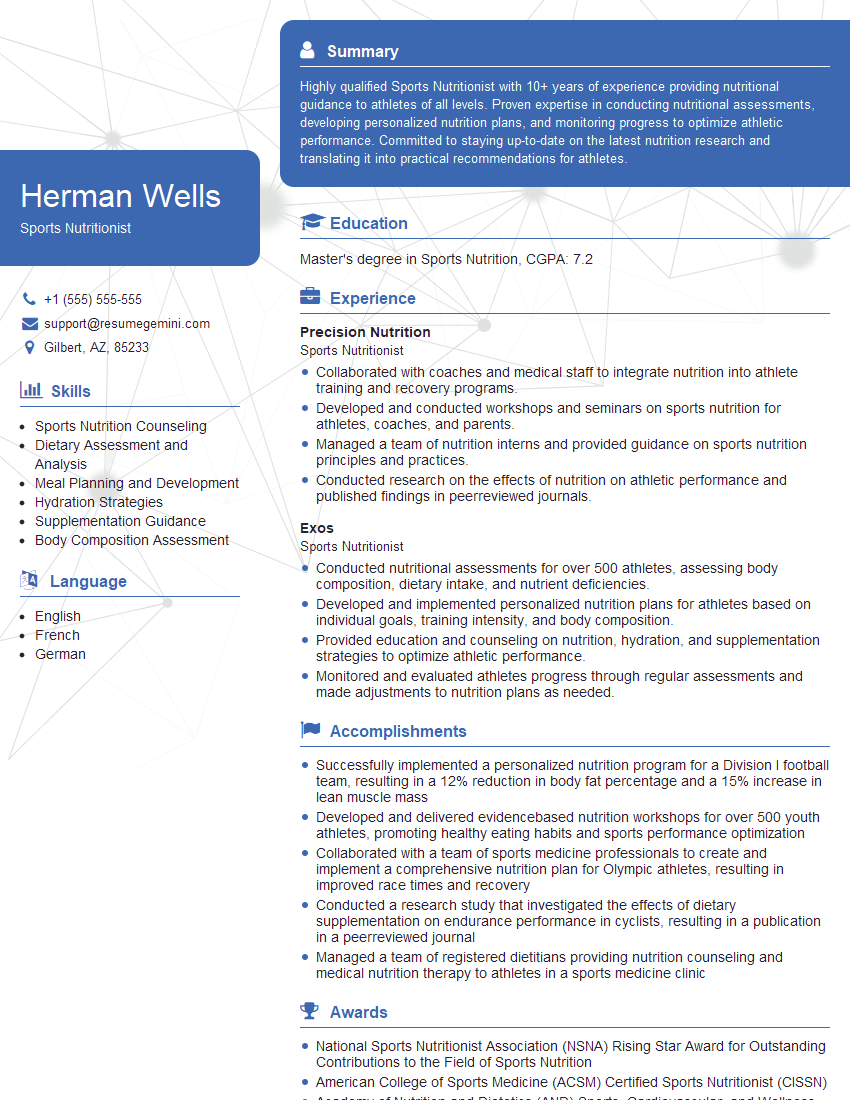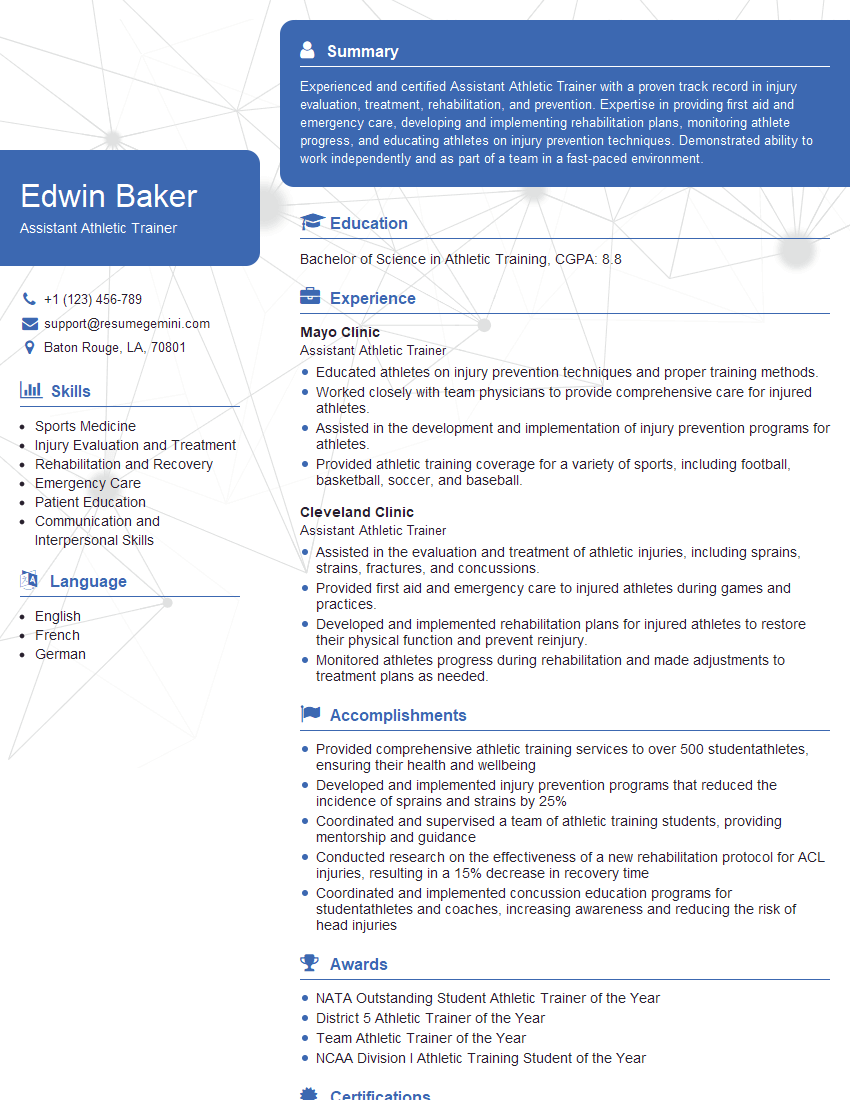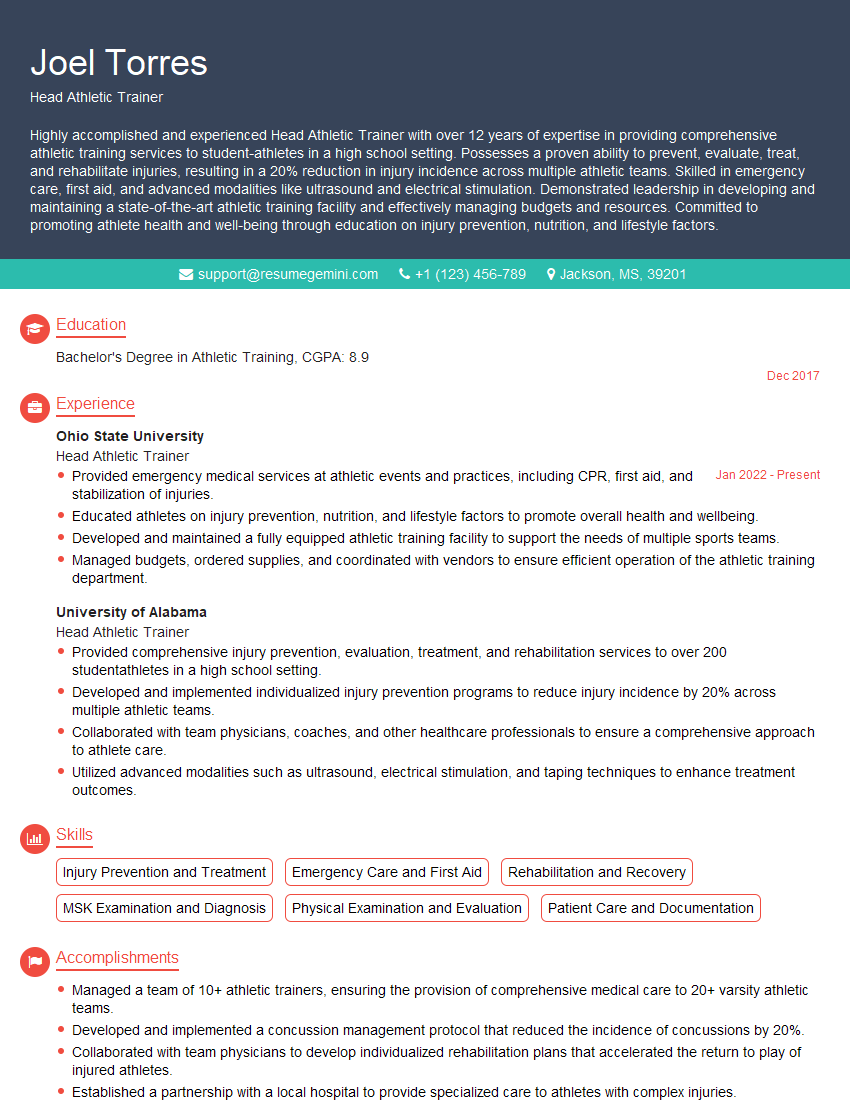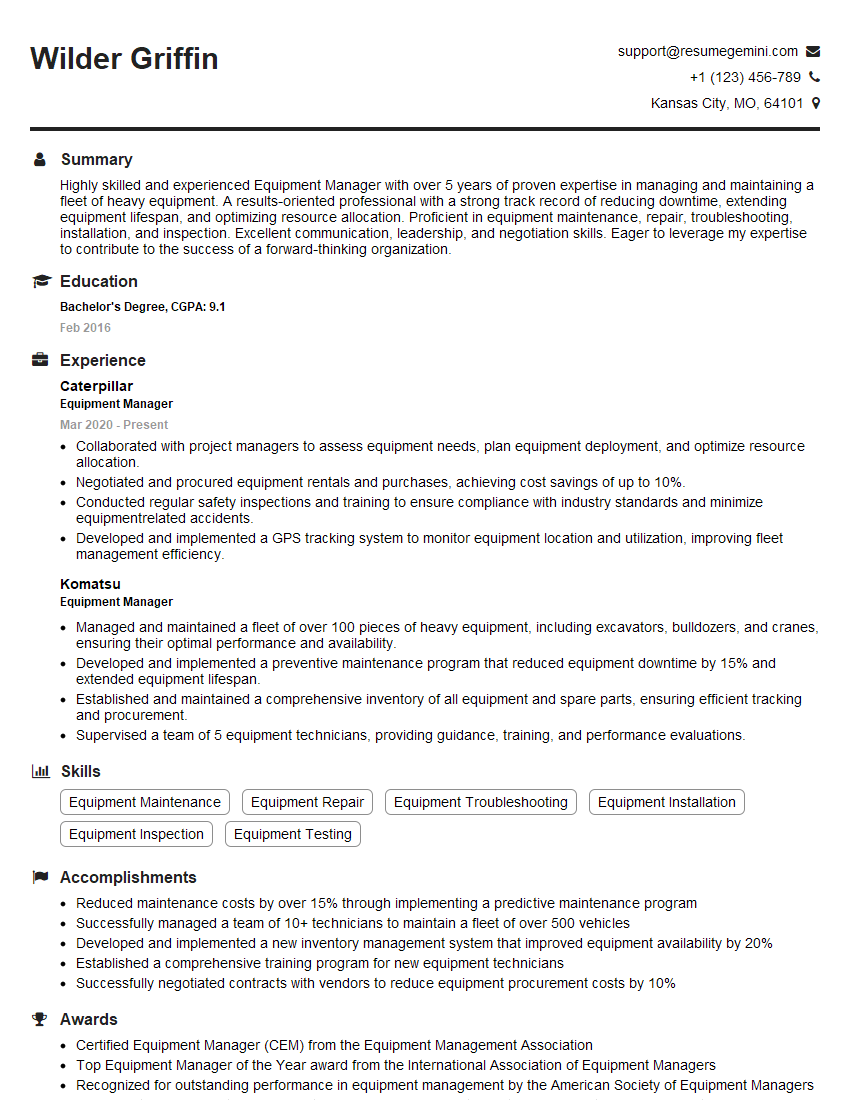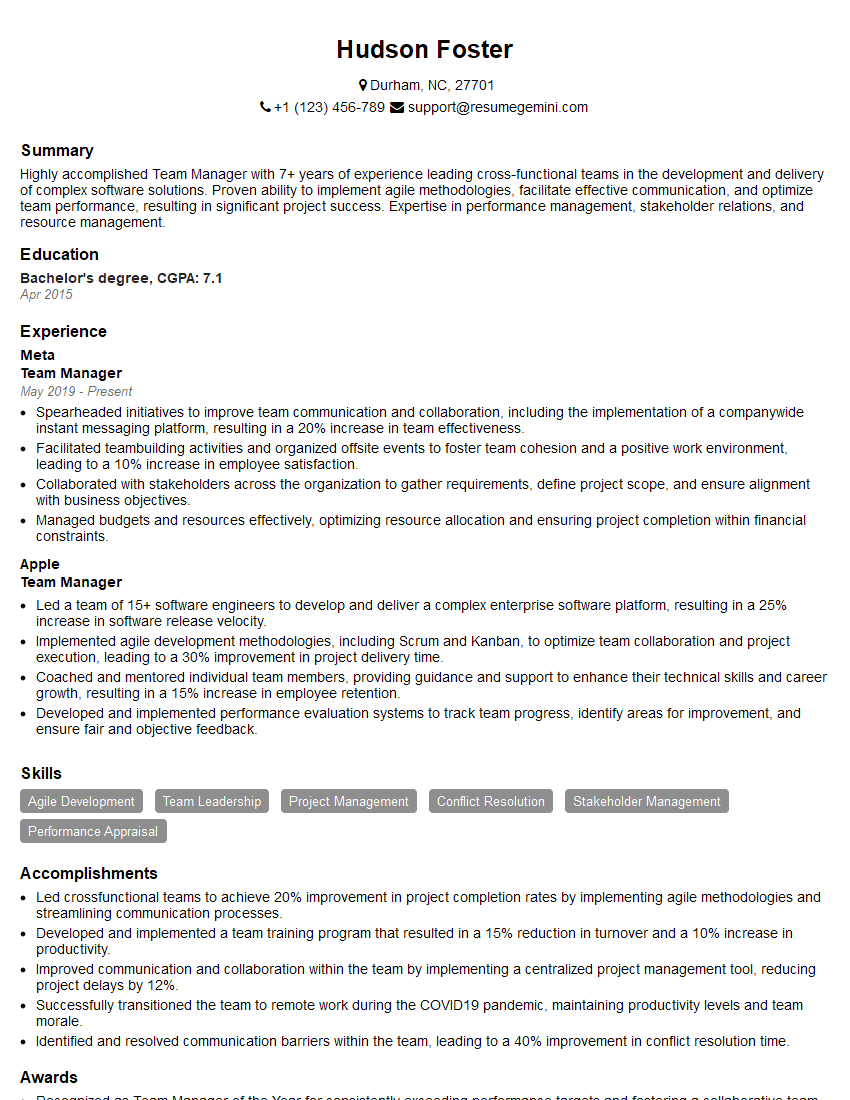Interviews are opportunities to demonstrate your expertise, and this guide is here to help you shine. Explore the essential Game Day Coaching interview questions that employers frequently ask, paired with strategies for crafting responses that set you apart from the competition.
Questions Asked in Game Day Coaching Interview
Q 1. Describe your experience managing on-field player substitutions during a game.
Managing on-field substitutions is a crucial aspect of game-day coaching, requiring a balance of strategic thinking and real-time assessment. My approach is multifaceted, prioritizing player performance, game situation, and team chemistry.
Before the game, I have a pre-determined substitution plan based on opponent analysis and player conditioning. This plan serves as a guideline, not a rigid script. During the game, I constantly monitor player fatigue, effectiveness, and potential matchups. For example, if a key player is struggling against a specific opponent, I’ll substitute to exploit a weakness or give the struggling player a break to regroup.
I also consider momentum shifts. If our team is on a roll, I may keep players in longer to maintain the momentum. Conversely, if the opponent is gaining an advantage, I might substitute to inject fresh energy and tactical changes. Effective communication with assistant coaches and players is paramount. Clear signals and quick substitutions are essential to avoid disruption. I often utilize a substitution board to keep track of player minutes and potential changes, allowing for swift decision-making.
Q 2. How do you adapt your game plan in response to unexpected injuries or opponent adjustments?
Unexpected injuries or opponent adjustments demand rapid adaptation. My strategy hinges on pre-game planning for contingencies and real-time problem-solving. If a key player is injured, I have backup plans in place. This involves having players who can fill multiple roles and a deep understanding of their capabilities. For instance, if our point guard is injured, I may need to adjust our offensive sets to leverage the strengths of the backup point guard or even change our defensive strategy.
Opponent adjustments require immediate analysis. I use the sideline staff to identify the change and relay it to the players. Then, we need to quickly assess its impact on our game plan. Does the change create a mismatch we can exploit? Does it compromise our original strategy? We might adjust offensive plays to counter a new defensive scheme or change our defensive strategy to contain a suddenly more effective offensive threat. This could involve shifting defensive assignments or altering our pressing strategies.
Q 3. Explain your process for communicating critical information to players during time-outs.
Timeouts are precious opportunities for clear, concise communication. My process focuses on brevity and impact. I use a structured approach, beginning with a quick acknowledgment of the current game situation, such as the score, time remaining, and momentum. I then highlight 1-2 key adjustments needed. These could be defensive adjustments (‘focus on denying their point guard the ball’), offensive adjustments (‘run more high post plays to exploit their zone’), or emotional adjustments (‘let’s stay composed and play our game’).
I avoid overwhelming players with too much information. Instead, I focus on the most critical points, providing clear visuals and simple instructions. I often use whiteboard diagrams or even hand gestures to illustrate key adjustments. Post-timeout execution is equally important. I ensure players understand their responsibilities and have a chance to ask clarifying questions. Following up with individual players after the timeout might be necessary to ensure they understood the message correctly.
Q 4. Describe your approach to motivating players during crucial moments in a game.
Motivating players during crucial moments requires a blend of emotional intelligence, strategic communication, and positive reinforcement. I avoid generic motivational speeches. Instead, I focus on specific examples, reminding players of their past successes and highlighting their capabilities. For example, ‘Remember that game against [opponent]? You shut them down in the fourth quarter. I know you can do it again.’ This connects to their past success and builds confidence.
I also emphasize team unity and the shared goal. This could involve a brief huddle where players remind each other of their individual and collective strengths. Furthermore, I use tactical adjustments to create opportunities for success. If players are struggling, I might use a timeout to change the game plan slightly, giving them a better chance to contribute. A positive, encouraging demeanor sets the tone. My focus is on belief in the players’ abilities, rather than applying excessive pressure.
Q 5. How do you utilize technology (e.g., video analysis) to improve game day performance?
Technology plays a significant role in improving game-day performance. Video analysis is invaluable for pre-game scouting and in-game adjustments. Pre-game, we use video to study the opponent’s tendencies, strengths, weaknesses, and preferred plays. This allows us to tailor our game plan and prepare specific countermeasures. During the game, we might review short clips of recent plays to identify areas for improvement or to adjust our strategies based on what the opponent is doing.
Beyond video, we use various other technological tools, such as performance tracking systems to monitor player exertion and fatigue, enabling more data-driven substitution decisions. We may also use statistical analysis to identify optimal lineups and play combinations. The integration of technology allows for a deeper, more informed understanding of the game, leading to more strategic and effective coaching decisions.
Q 6. How do you manage the emotional state of the team during high-pressure situations?
Managing the team’s emotional state under pressure is critical. My approach combines a calm, supportive presence with clear communication and targeted strategies. Maintaining a calm demeanor is crucial; panic is contagious. I use positive reinforcement and encourage players to focus on the present moment, not dwell on past mistakes or future uncertainties. I frequently remind players of their training and their capabilities, stressing that they’re prepared for the challenge.
I address individual players’ emotional states as needed. Some might need encouragement, others might need a brief reprimand. The key is to understand each player’s personality and response to pressure. I ensure all communication is focused, constructive, and supportive. Strategic timeouts can be used to reset the emotional dynamic, allowing for a brief regrouping and refocusing of the team’s energy.
Q 7. Explain your strategy for delegating responsibilities to assistant coaches on game day.
Delegation on game day is essential for effective coaching. My approach is based on trust, clear roles, and open communication. Before the game, I assign specific responsibilities to each assistant coach based on their expertise and experience. One might be responsible for scouting and communicating opponent adjustments, another for tracking player statistics and fatigue, and another might focus on in-game video analysis.
I ensure clear communication channels among the assistants and myself. During the game, I leverage their insights and expertise, creating a collaborative coaching environment. Regular communication, including clear signals and concise updates, is vital for maintaining the flow of information. I also trust my assistants to make certain decisions autonomously, freeing me to focus on the bigger picture. This distributed decision-making process leads to faster responses and increased efficiency during game-day operations.
Q 8. How do you ensure clear and efficient communication between the coaching staff and players?
Clear and efficient communication is the bedrock of any successful coaching staff. It’s not just about shouting instructions; it’s about building a system of understanding and trust. We achieve this through several key strategies:
Pre-game meetings: These aren’t just about strategy; they’re about clarifying roles, responsibilities, and expected communication channels. For example, we might establish hand signals for specific plays or use coded language to quickly adjust strategy on the field without disrupting the flow of the game.
Designated communication roles: We have specific assistants responsible for relaying information to different player groups. This ensures messages reach the right people at the right time. For instance, one coach might focus on the offensive line, while another handles the defensive backs.
Open feedback channels: We encourage players to communicate concerns or suggestions immediately. This might involve short, quick conversations on the sidelines, or more formal post-play reviews. This ensures we don’t miss critical details or overlook valuable player insight.
Consistent language: We use clear, concise language, avoiding jargon or ambiguous terms. Every player understands the terminology, which eliminates potential misunderstandings during crucial game moments.
Q 9. Describe your experience handling conflicts or disagreements between players during a game.
Disagreements between players are inevitable, especially under the pressure of competition. My approach centers on de-escalation and finding a solution that benefits the team. I don’t tolerate personal attacks but encourage open discussion of tactical differences.
Immediate intervention: If a conflict arises, I intervene immediately, separating the players to prevent escalation. I let them know that while healthy debate is okay, disrupting the team’s performance is unacceptable.
Individual conversations: I then speak with each player individually, understanding their perspectives without judgment. This helps uncover the root cause of the disagreement – whether it’s a misunderstanding, a difference in playing style, or even fatigue.
Team-oriented solution: I work with the players to develop a collaborative solution. This may involve adjusting roles, clarifying expectations, or finding ways to integrate their different approaches for the collective good of the team. This reinforces teamwork and resolves conflicts in a positive manner.
Reinforce team values: I consistently emphasize the importance of teamwork, sportsmanship, and mutual respect. This proactive approach minimizes the frequency and intensity of future disagreements.
Q 10. How do you evaluate the effectiveness of your game day strategies?
Evaluating game day strategy effectiveness is a multi-faceted process that extends beyond the final score. It involves a thorough review of various aspects using both quantitative and qualitative data.
Statistical analysis: We analyze game statistics—yards gained, turnovers, time of possession, completion percentage, etc.—to understand which strategies worked and which didn’t. For example, a high turnover rate might indicate a need to adjust our offensive or defensive approach.
Film review: We meticulously review game footage to identify trends, missed opportunities, and execution errors. This helps us see what worked well and identify areas for improvement.
Player feedback: Post-game feedback sessions, both individually and as a team, are critical. Players offer valuable insight into what felt effective and what didn’t, from their perspective on the field.
Opponent analysis: We examine the opponent’s strategy and how our own approach countered it. This helps refine strategies for future encounters.
By combining these different assessment methods, we get a holistic view of our strategy’s effectiveness and pinpoint areas requiring refinement.
Q 11. Describe a time you had to make a quick, critical decision during a game. What was the outcome?
In a crucial playoff game, we were down by one point with seconds remaining. The opponent had the ball, and their quarterback was known for his scrambling ability. I had to decide whether to blitz, risking a potential touchdown, or play a conservative coverage, potentially giving them an easy first down.
I chose a hybrid approach—a controlled blitz with a safety playing deep coverage to prevent the long pass. The quarterback was pressured and threw an incomplete pass, and we won the game on the final play. The outcome hinged on correctly assessing the risk and reward—a calculated gamble that paid off thanks to meticulous preparation and a solid defensive execution.
Q 12. How do you incorporate player feedback into your game day decisions?
Player feedback is invaluable. I make a point of incorporating it into my game day decisions through:
Open communication: Creating an environment where players feel comfortable expressing their opinions is paramount. This means actively soliciting feedback, not just passively listening.
Pre-game discussions: Incorporating players’ insights during pre-game strategy discussions can help us fine-tune our game plan based on their observations or previous experiences against the same opponent.
Real-time adjustments: During the game, if a player points out a weakness in the opponent’s defense, we might adjust our play calls on the fly. This requires trust and responsiveness.
Post-game reviews: Detailed post-game analyses incorporate player perspectives on their execution, which informs future game planning.
While coaching decisions ultimately rest with me, I leverage player insights to make well-informed choices and boost team morale by demonstrating respect for their expertise.
Q 13. How familiar are you with the rulebook and its implications on game day decisions?
Familiarity with the rulebook is non-negotiable. My knowledge isn’t just theoretical; it’s deeply ingrained through years of experience and continuous study. It directly impacts my game day decisions because:
Fair play: Understanding the rules ensures we play fair and avoid penalties that could cost us the game.
Strategic advantage: Knowledge of the rulebook allows us to exploit loopholes or gray areas within the rules legally, without jeopardizing fair play.
Challenge calls: This includes knowing when to challenge calls and the timing regulations associated with these challenges.
Player safety: Deep rule understanding helps me make decisions that prioritize player safety and abide by the rules.
I regularly review rule updates, and this helps us avoid costly mistakes.
Q 14. Explain your process for preparing a game plan and adapting it as needed.
Developing a game plan and adapting it involves a systematic process:
Opponent analysis: We thoroughly scout the opposing team, studying their strengths, weaknesses, tendencies, and past performances.
Team assessment: We assess our own team’s strengths, weaknesses, and overall readiness, considering injuries or other limiting factors.
Initial game plan: We create a baseline game plan, incorporating strategies to exploit the opponent’s weaknesses while minimizing our team’s vulnerabilities.
Practice implementation: The game plan is rigorously tested and refined during practice, allowing players to become comfortable with the plays and strategies.
In-game adaptation: The most crucial part – we continuously monitor the game’s flow, assessing our performance and the opponent’s responses. If needed, we adjust the game plan in real-time based on what we observe. This is where experience and fast decision-making skills really matter.
This iterative process allows us to maximize our chances of success, adjusting to the unpredictable nature of game day events.
Q 15. Describe your understanding of opponent scouting and its role in game day success.
Opponent scouting is the cornerstone of effective game day strategy. It’s not just about identifying the opposing team’s star players; it’s about understanding their entire game plan, including their strengths, weaknesses, typical formations, tendencies, and even their coaching style. We analyze film meticulously, looking for patterns in their offensive and defensive plays, their player rotations, and their responses to different game situations. For example, we might notice a team consistently struggles against specific offensive formations, or that their quarterback panics under pressure from a particular blitz package. This information allows us to develop a counter-strategy that leverages their weaknesses and mitigates our own vulnerabilities.
This process informs every aspect of our game plan, from player assignments and formations to in-game adjustments. We use this intel to create a comprehensive game plan with contingencies for different scenarios. The more thorough the scouting, the better prepared we are to exploit opponent weaknesses and minimize our own risks, significantly increasing our chances of success on game day.
Career Expert Tips:
- Ace those interviews! Prepare effectively by reviewing the Top 50 Most Common Interview Questions on ResumeGemini.
- Navigate your job search with confidence! Explore a wide range of Career Tips on ResumeGemini. Learn about common challenges and recommendations to overcome them.
- Craft the perfect resume! Master the Art of Resume Writing with ResumeGemini’s guide. Showcase your unique qualifications and achievements effectively.
- Don’t miss out on holiday savings! Build your dream resume with ResumeGemini’s ATS optimized templates.
Q 16. How do you handle pressure and maintain composure under stressful game day conditions?
Game day pressure is immense, but managing it is a skill honed through experience. My approach is multifaceted. Firstly, I focus on preparation. Thorough planning, ensuring all logistics are handled well in advance, removes a significant source of stress. Secondly, I rely on a deep breath and a clear mind. Visualization techniques and positive self-talk help me maintain focus. Thirdly, I actively delegate. I empower my assistant coaches to handle specific tasks and decisions, allowing me to concentrate on the bigger picture. Lastly, I trust my team. Knowing my players are prepared and capable allows me to maintain composure. Think of it like a conductor leading an orchestra – even amidst the chaos, a calm demeanor inspires confidence in the musicians.
In a crucial game moment, I might use a short, quiet moment to regroup, focusing on the next immediate play rather than dwelling on past mistakes. This allows me to make rational decisions and adjust strategy effectively.
Q 17. What are your strategies for ensuring player safety and well-being during a game?
Player safety is paramount. Our approach is proactive, beginning long before game day with rigorous physical conditioning and injury prevention programs. On game day itself, we have a dedicated medical team on the sidelines equipped to handle immediate injuries. We emphasize proper tackling techniques during practice and closely monitor players for signs of fatigue or injury during the game. Players are instructed to immediately report any discomfort or pain. Substitution strategies are implemented to manage player workloads and prevent overuse injuries. We also strictly adhere to all league rules and regulations concerning player safety, including concussion protocols. If a player shows any signs of concussion, they are immediately removed from the game and evaluated by medical professionals.
For example, we might substitute a player who’s had repeated hard hits even if they don’t show any overt injury to prevent long-term problems. This proactive approach is essential to ensuring player well-being and fostering a culture of safety within the team.
Q 18. Describe your experience managing game day logistics (equipment, personnel, etc.)
Managing game day logistics is a significant undertaking requiring meticulous planning and coordination. It starts weeks before the game with equipment checks, ensuring all uniforms, protective gear, and playing equipment are in optimal condition. We have a detailed checklist for every item, from helmets and pads to first-aid kits and water bottles. Communication with our support staff, including trainers, equipment managers, and security personnel, is crucial. We establish clear roles and responsibilities to avoid confusion and ensure smooth execution. Game day itself involves coordinating player arrival, warm-ups, halftime adjustments, and post-game procedures. A typical game day will include the pre-game meeting, confirming the starting line-up and ensuring that the team is mentally prepared for the game. We use digital tools and communication systems to streamline information flow and ensure everyone is informed of any changes or developments.
We often conduct a full walkthrough of the stadium before the game, addressing any unforeseen challenges related to the playing conditions, facilities, and the opponent’s style of play. We hold regular briefings and meetings to ensure that everyone is on the same page and addresses any potential problems well before they impact the game.
Q 19. How do you maintain a positive and supportive team environment during challenging games?
Maintaining a positive team environment during challenging games is critical. My strategy is based on three pillars: communication, encouragement, and accountability. I foster open communication, ensuring players feel comfortable expressing their concerns and frustrations. I believe in leading by example, displaying positivity and resilience even during setbacks. This extends to consistent encouragement for both individual and team performance. We regularly celebrate small victories and acknowledge effort, even when results aren’t ideal. At the same time, we hold players accountable for their actions and performance without resorting to negativity or blame. It’s about fostering a culture of mutual respect and support. We regularly engage in team-building activities and create opportunities for players to connect beyond the field. This team unity is crucial when facing adversity.
For example, after a dropped pass or a missed tackle, we focus on the lessons learned and encourage the player to continue playing hard. The goal is to create an environment where players feel empowered and capable, even under pressure.
Q 20. How do you identify and address individual player performance issues during a game?
Addressing individual player performance issues during a game requires a delicate balance of direct feedback and supportive coaching. I avoid public criticism, opting instead for private conversations during timeouts or after plays. I use direct but constructive language, focusing on specific actions rather than making general judgments. I might say, ‘Your footwork on that last play was slightly off. Let’s try adjusting your stance,’ instead of, ‘You’re playing poorly.’ I also emphasize the importance of learning from mistakes and offer tactical advice for improvement. It’s about making adjustments to help the player regain confidence and improve their performance. Sometimes, a simple adjustment to their position or role might be all that is needed to improve the player’s overall contribution to the game. If the issue is persistent, I will usually conduct a more comprehensive analysis of their performance to identify root causes.
The key is to keep the focus on improving performance and supporting the player, rather than dwelling on past failures.
Q 21. How do you balance the need for immediate adjustments with long-term strategic goals?
Balancing immediate adjustments with long-term strategic goals is a constant challenge in game day coaching. It’s a bit like navigating a ship – you need to make course corrections to avoid immediate obstacles, but also keep your eye on the destination. I approach this using a framework of prioritization and adaptability. Immediate adjustments often focus on exploiting opponent weaknesses or countering their tactical shifts. These are short-term actions aimed at gaining immediate advantage. Long-term goals, on the other hand, are about developing player skills, refining our overall game plan, and achieving consistent performance. I create a flexible game plan that can adapt to various situations while still working towards the overarching strategic objectives.
For example, I might call a specific play to capitalize on a defensive mismatch, (an immediate adjustment) while still adhering to the broader game plan of controlling the clock and maintaining possession (a long-term goal). This balance ensures we are responding effectively to the current game while always progressing toward our overall objectives.
Q 22. Explain your process for post-game analysis and using it to improve future performance.
Post-game analysis is crucial for continuous improvement. My process begins immediately after the game, starting with a quick team meeting to debrief the emotions and overall performance. Then, I move to a more detailed analysis, leveraging film review and statistical data. This involves:
- Film Breakdown: We meticulously review every play, identifying successful and unsuccessful strategies, individual player performances, and overall team execution.
- Statistical Analysis: We delve into advanced statistics beyond basic scores. This helps pinpoint areas of strength and weakness, offering quantifiable data to support our observations from the film.
- Individual Player Assessments: We evaluate each player’s contribution, highlighting their strengths, areas for improvement, and focusing on both the technical and mental aspects of their game.
- Strategic Adjustments: Based on the analysis, we identify areas needing tactical adjustments. For example, if our opponent’s zone defense consistently thwarted our inside game, we would develop strategies to counter it, such as employing more perimeter shots or pick-and-roll plays.
- Team Meeting Feedback: Finally, we conduct a constructive team meeting, sharing our findings and implementing a plan for improvement. This ensures everyone understands their role in addressing identified weaknesses and capitalizing on strengths.
For example, if we lost a game due to a high turnover rate in the second half, the analysis would focus on identifying the cause (pressure defense, poor decision-making under pressure, etc.). Then, we would develop specific drills and game strategies to address this weakness in future games. This iterative process ensures we continuously learn and adapt.
Q 23. Describe your familiarity with various offensive and defensive strategies.
My familiarity with offensive and defensive strategies is extensive, spanning various sports. I understand different formations, play calls, and their respective advantages and disadvantages. On the offensive side, I’m adept at utilizing various schemes including:
- Spread Offense: Maximizes spacing and uses various passing plays and running plays to attack the defense.
- West Coast Offense: Emphasizes short, high-percentage passes, quick releases, and efficient play calling.
- Power Running: Uses physical blocking and strong running backs to gain yardage consistently.
Defensively, I’m well-versed in strategies such as:
- Zone Defense: Different zones (cover 2, cover 3, etc.) have various advantages and disadvantages in relation to specific offensive strategies. Understanding offensive tendencies is key.
- Man-to-Man Defense: Each defender is assigned a specific opponent and covers them throughout the play. It’s very demanding for players.
- Blitzing: Sending extra rushers to pressure the quarterback.
My understanding extends beyond basic schemes. I consider situational factors (score, time remaining, opponent tendencies) when choosing the optimal strategy, adapting my approach as needed. It’s less about rigidly adhering to a playbook and more about strategic flexibility.
Q 24. How do you collaborate effectively with other departments (e.g., athletic training, sports medicine)?
Effective collaboration with other departments is paramount for player health and performance. I maintain open communication channels with athletic training and sports medicine staff, regularly discussing:
- Player Injuries and Conditions: I receive regular updates on injuries and fitness levels to tailor training and game-day strategies accordingly. We ensure that any limitations are considered.
- Injury Prevention Strategies: We collaboratively devise and implement injury prevention strategies, such as customized workout plans and proper warm-up routines.
- Game Day Management: During games, we coordinate closely. If a player gets injured, the athletic trainers and I work together to assess the situation and make informed decisions regarding their continued participation.
- Rehabilitation and Recovery: We work closely with sports medicine on the recovery plan for injured players, integrating it into their return-to-play process.
For example, if a key player is dealing with a minor hamstring strain, we work together to limit their participation in high-impact drills, carefully manage their playing time, and ensure proper warm-up and cool-down exercises.
Q 25. How do you evaluate the effectiveness of your coaching staff on game day?
Evaluating my coaching staff on game day relies on a multifaceted approach that considers both preparedness and on-the-field performance. This includes:
- Pre-Game Preparation: I assess their contributions to the game plan, their communication with players, and their ability to manage the team during preparation.
- In-Game Adjustments: I observe how effectively they adapt to the opponent’s strategies and make real-time adjustments. This requires quick thinking and decisiveness.
- Player Development: I evaluate their ability to motivate and inspire players, encourage their improvement and their role in delivering constructive feedback.
- Communication and Collaboration: Effective communication among the coaching staff is vital. I assess their teamwork and ability to work together seamlessly.
- Post-Game Analysis: Their involvement in post-game analysis and contribution to identifying areas for improvement is also considered.
For instance, if an assistant coach’s strategy proved particularly effective in neutralizing an opposing player, I would recognize and appreciate their contribution. If, however, adjustments weren’t made effectively during the game, that would become a point of discussion and improvement.
Q 26. Describe a time you had to make a tough call that impacted a player’s playing time.
In a crucial playoff game, a star player, who was usually a consistent performer, had an unusually poor first half. He was visibly frustrated and making uncharacteristic errors. The decision to bench him was difficult, as he was our key player, but necessary for the team’s success. I pulled him aside, explained my reasoning calmly, and focused on his mental state, not just his performance. It wasn’t about punishment; it was about restoring focus and giving him a chance to regroup.
After a motivational talk, he re-entered in the second half. His improved play contributed to our comeback victory. Post-game, we discussed the situation further; the experience served as a valuable learning moment for him, fostering resilience and the understanding that even star players need to adapt during challenging games. Open communication and showing empathy was vital.
Q 27. How do you utilize different communication methods (verbal, non-verbal) to connect with players?
Effective communication, both verbal and nonverbal, is foundational to success. I utilize a variety of methods to connect with players.
- Verbal Communication: This includes individual meetings, team talks (before and after games and practice), and providing constructive feedback during practices. Clarity and empathy are crucial.
- Nonverbal Communication: My body language, facial expressions, and tone of voice communicate my expectations and levels of support. A firm but encouraging demeanor is vital. I prioritize active listening to understand their perspective.
- Written Communication: I utilize emails, text messages for immediate updates, and occasionally, written notes of encouragement or feedback.
For example, a simple pat on the back after a good play conveys encouragement without needing words. Conversely, a direct, private conversation can provide constructive criticism that wouldn’t be appropriate for a public setting.
Q 28. Describe your approach to developing and maintaining a strong team culture on game day.
Cultivating a strong team culture on game day is about building unity and focus. My approach involves:
- Team Unity: I foster a supportive environment where players feel comfortable expressing themselves and supporting each other. Team-building exercises, both on and off the field, play a vital role.
- Shared Goals: We establish clear, shared objectives so everyone understands their role in achieving victory. This aligns our efforts towards a common purpose.
- Positive Reinforcement: Consistent positive reinforcement boosts confidence and morale. I celebrate successes, both big and small.
- Accountability: While fostering a supportive atmosphere, it is important to ensure that players take accountability for their actions and performance. This cultivates ownership.
- Game Day Rituals: Establishing consistent pre-game routines creates a sense of familiarity and control, reducing anxiety and improving performance. These rituals could include team prayers, motivational speeches, and warm-up drills.
For example, if a player makes a mistake, instead of focusing solely on the error, I address it constructively, emphasizing learning and improvement. This approach builds trust and ensures everyone feels valued and respected.
Key Topics to Learn for Game Day Coaching Interview
- Game Day Strategy & Planning: Understanding the importance of pre-game preparation, including analyzing opponent strategies, developing contingency plans, and adapting to changing game conditions.
- In-Game Adjustments & Communication: Demonstrating your ability to effectively communicate with players during the game, make real-time adjustments based on performance, and maintain composure under pressure.
- Player Motivation & Management: Explaining your techniques for motivating players, building team cohesion, addressing individual challenges, and fostering a positive team environment.
- Performance Analysis & Feedback: Describing your process for analyzing game performance, identifying areas for improvement, and providing constructive feedback to players to enhance future performance.
- Understanding Game Rules & Regulations: Showcasing your thorough knowledge of the specific game rules and regulations, and your ability to apply them effectively during gameplay and coaching.
- Ethical Considerations & Sportsmanship: Articulating your commitment to ethical coaching practices, promoting good sportsmanship, and fostering a respectful environment for all participants.
- Technological Integration (if applicable): Discussing your familiarity with any relevant game-day technologies, such as video analysis software or performance tracking systems.
Next Steps
Mastering Game Day Coaching principles is crucial for career advancement in the sports industry. It demonstrates your leadership capabilities, strategic thinking, and ability to manage high-pressure situations. To significantly enhance your job prospects, crafting an ATS-friendly resume is essential. This ensures your application gets noticed by recruiters and hiring managers. We highly recommend using ResumeGemini to build a professional and impactful resume. ResumeGemini provides you with the tools and resources necessary to create a compelling narrative of your skills and experience. Examples of resumes tailored specifically to Game Day Coaching positions are available for your review.
Explore more articles
Users Rating of Our Blogs
Share Your Experience
We value your feedback! Please rate our content and share your thoughts (optional).
What Readers Say About Our Blog
Hello,
We found issues with your domain’s email setup that may be sending your messages to spam or blocking them completely. InboxShield Mini shows you how to fix it in minutes — no tech skills required.
Scan your domain now for details: https://inboxshield-mini.com/
— Adam @ InboxShield Mini
Reply STOP to unsubscribe
Hi, are you owner of interviewgemini.com? What if I told you I could help you find extra time in your schedule, reconnect with leads you didn’t even realize you missed, and bring in more “I want to work with you” conversations, without increasing your ad spend or hiring a full-time employee?
All with a flexible, budget-friendly service that could easily pay for itself. Sounds good?
Would it be nice to jump on a quick 10-minute call so I can show you exactly how we make this work?
Best,
Hapei
Marketing Director
Hey, I know you’re the owner of interviewgemini.com. I’ll be quick.
Fundraising for your business is tough and time-consuming. We make it easier by guaranteeing two private investor meetings each month, for six months. No demos, no pitch events – just direct introductions to active investors matched to your startup.
If youR17;re raising, this could help you build real momentum. Want me to send more info?
Hi, I represent an SEO company that specialises in getting you AI citations and higher rankings on Google. I’d like to offer you a 100% free SEO audit for your website. Would you be interested?
Hi, I represent an SEO company that specialises in getting you AI citations and higher rankings on Google. I’d like to offer you a 100% free SEO audit for your website. Would you be interested?
good
